1997 HONDA ODYSSEY fuel cap
[x] Cancel search: fuel capPage 1 of 241
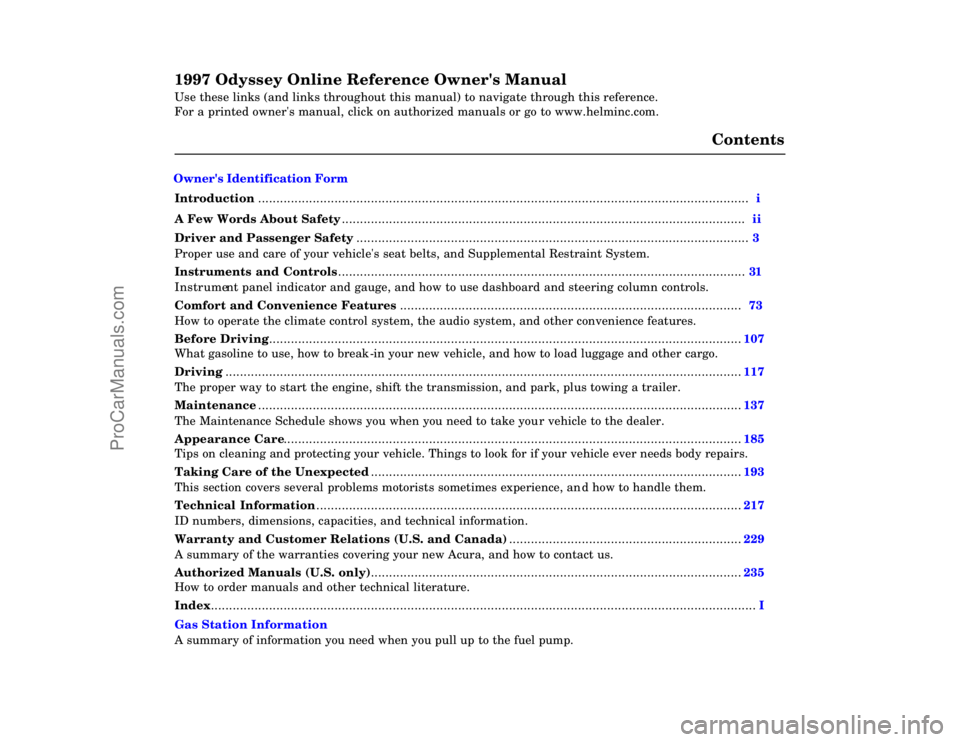
1997 Odyssey Online Reference Owner's Manual
Use these links (and links throughout this manual) to navigate through\
this reference.
For a printed owner's manual, click on authorized manuals or go to www.h\
elminc.com.
Contents
Owner's Identification Form
Introduction ........................................................................\
............................................................... i
A Few Words About Safety........................................................................\
....................................... ii
Driver and Passenger Safety ........................................................................\
.................................... 3
Proper use and care of your vehicle's seat belts, and Supplemental Restr\
aint System.
Instruments and Control s........................................................................\
........................................ 31
Instrument panel indicator and gauge, and how to use dashboard and steering colu\
mn controls.
Comfort and Convenience Features ........................................................................\
...................... 73
How to operate the climate control system, the audio system, and other c\
onvenience features.
Before Driving........................................................................\
..........................................................107
What gasoline to use, how to break -in your new vehicle, and how to load luggage and other cargo.
Driving ........................................................................\
......................................................................117
The proper way to start the engine, shift the transmission, and park, pl\
us towing a trailer.
Maintenance........................................................................\
.............................................................137
The Maintenance Schedule shows you when you need to take you r vehicle to the dealer.
Appearance Car e........................................................................\
..................................................... .185
Tips on cleaning and protecting your vehicle. Things to look for if your\
vehicle ever needs body repairs.
Taking Care of the Unexpecte d........................................................................\
..............................193
This section covers several problems motorists sometimes experience, an d how to handle them.
Technical Informatio n........................................................................\
.............................................217
ID numbers, dimensions, capacities, and technical information.
Warranty and Customer Relations (U.S. and Canada)................................................................229
A summary of the warranties covering your new Acura, and how to contact \
us.
Authorized Manu als (U.S. only)........................................................................\
..............................235
How to order manuals and other technical literature.
Index........................................................................\
.............................................................................. I
Gas Station Information
A summary of information you need when you pull up to the fuel pump.
ProCarManuals.com
Page 110 of 241
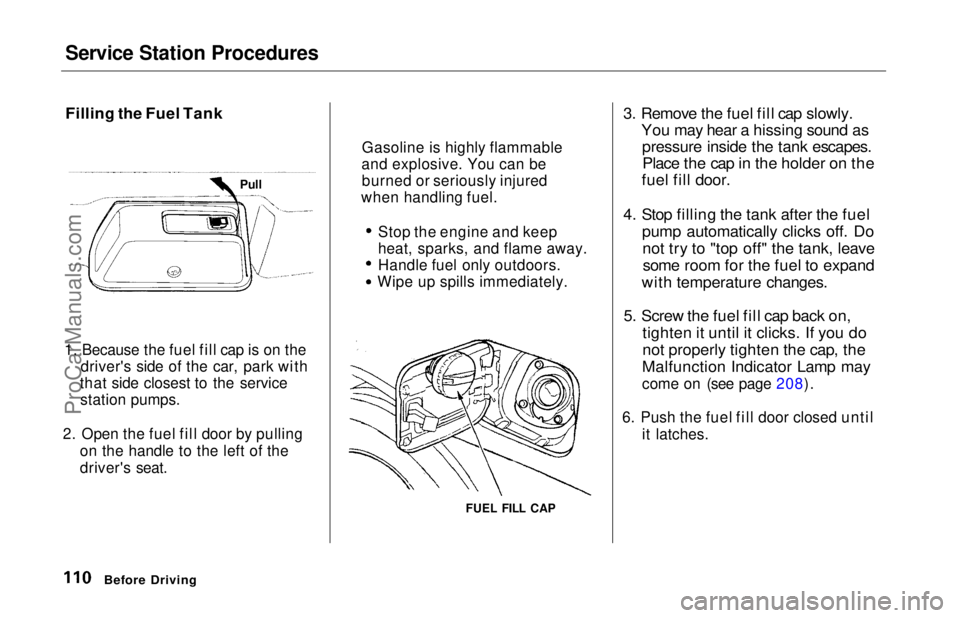
Service Station Procedures
Filling the Fuel Tank
1. Because the fuel fill cap is on the driver's side of the car, park with
that side closest to the service station pumps.
2. Open the fuel fill door by pulling on the handle to the left of the
driver's seat.
3. Remove the fuel fill cap slowly.
You may hear a hissing sound aspressure inside the tank escapes.Place the cap in the holder on the
fuel fill door.
4. Stop filling the tank after the fuel pump automatically clicks off. Donot try to "top off" the tank, leavesome room for the fuel to expand
with temperature changes.
5. Screw the fuel fill cap back on, tighten it until it clicks. If you do
not properly tighten the cap, the
Malfunction Indicator Lamp may
come on (see page 208).
6. Push the fuel fill door closed until it latches.
Before Driving
Pull
FUEL FILL CAP
Gasoline is highly flammable
and explosive. You can be burned or seriously injured
when handling fuel. Stop the engine and keep
heat, sparks, and flame away.
Handle fuel only outdoors.
Wipe up spills immediately.ProCarManuals.comMain Menu Table of Contents s t
Page 147 of 241
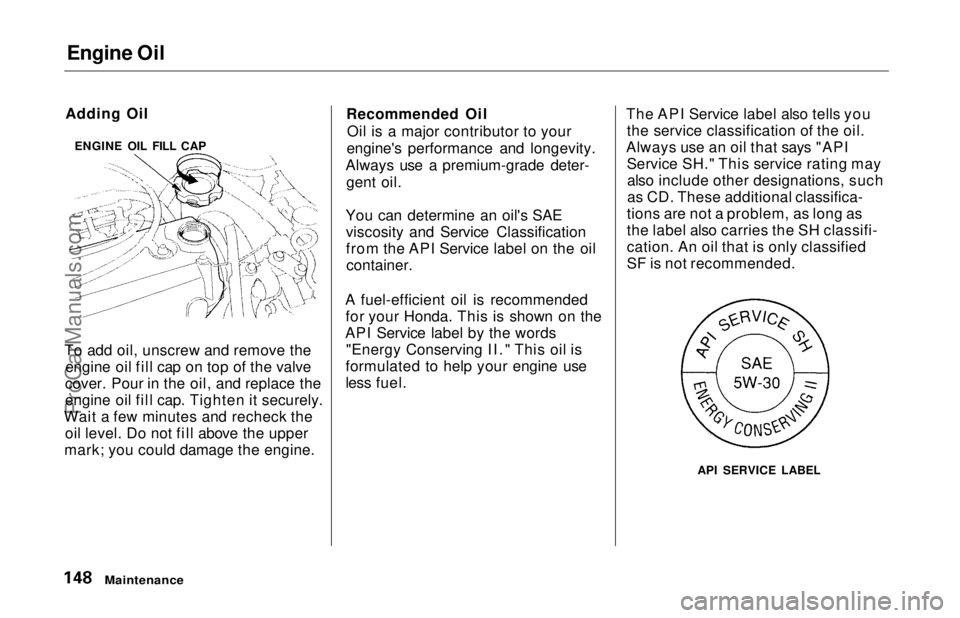
Engine Oil
Adding Oil
To add oil, unscrew and remove the engine oil fill cap on top of the valve
cover. Pour in the oil, and replace the
engine oil fill cap. Tighten it securely.
Wait a few minutes and recheck the oil level. Do not fill above the upper
mark; you could damage the engine. Recommended Oil
Oil is a major contributor to your
engine's performance and longevity.
Always use a premium-grade deter- gent oil.
You can determine an oil's SAE viscosity and Service Classification
from the API Service label on the oilcontainer.
A fuel-efficient oil is recommended for your Honda. This is shown on the
API Service label by the words "Energy Conserving II." This oil is
formulated to help your engine use
less fuel. The API Service label also tells you
the service classification of the oil.
Always use an oil that says "API Service SH." This service rating mayalso include other designations, such
as CD. These additional classifica-
tions are not a problem, as long as
the label also carries the SH classifi-
cation. An oil that is only classified
SF is not recommended.
API SERVICE LABEL
Maintenance
ENGINE OIL FILL CAPProCarManuals.comMain Menu Table of Contents s t
Page 155 of 241
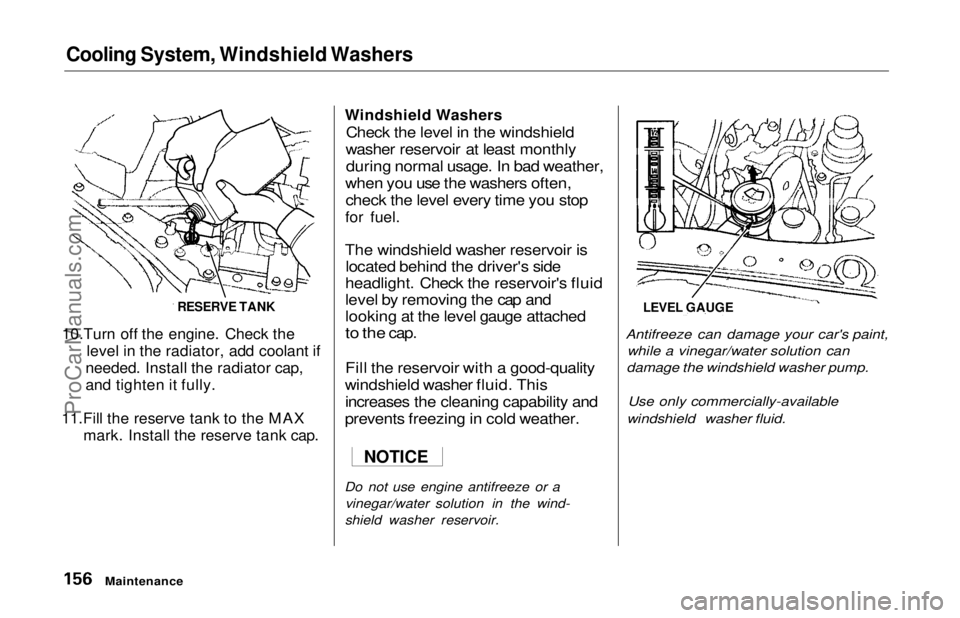
Cooling System, Windshield Washers
10.Turn off the engine. Check the level in the radiator, add coolant if
needed. Install the radiator cap,
and tighten it fully.
11.Fill the reserve tank to the MAX mark. Install the reserve tank cap. Windshield Washers
Check the level in the windshield
washer reservoir at least monthly during normal usage. In bad weather,
when you use the washers often, check the level every time you stop
for fuel.
The windshield washer reservoir is located behind the driver's side
headlight. Check the reservoir's fluid
level by removing the cap and
looking at the level gauge attached
to the
cap.
Fill the reservoir with a good-quality
windshield washer fluid. This increases the cleaning capability and
prevents freezing in cold weather.
Do not use engine antifreeze or a vinegar/water solution in the wind-
shield washer reservoir.
Antifreeze can damage your car's paint,
while a vinegar/water solution can
damage the windshield washer pump.
Use only commercially-available
windshield washer fluid.
Maintenance
RESERVE TANK
LEVEL GAUGE
NOTICEProCarManuals.comMain Menu Table of Contents s t
Page 206 of 241
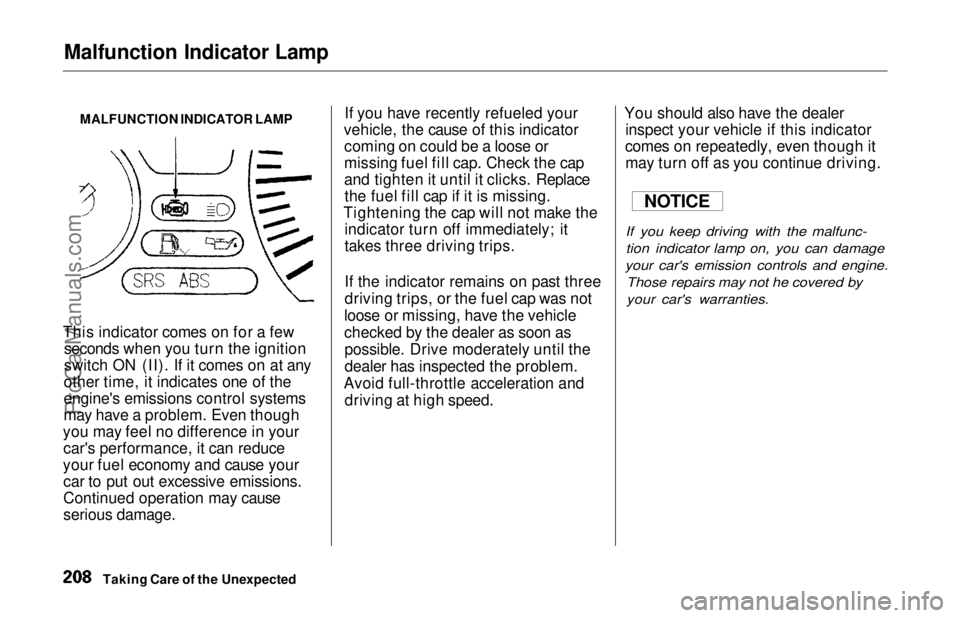
Malfunction Indicator Lamp
MALFUNCTION INDICATOR LAMP
This indicator comes on for a few seconds when you turn the ignition
switch ON (II). If it comes on at any
other time, it indicates one of the
engine's emissions control systems
may have a problem. Even though
you may feel no difference in your car's performance, it can reduce
your fuel economy and cause your car to put out excessive emissions.
Continued operation may cause
serious damage. If you have recently refueled your
vehicle, the cause of this indicator coming on could be a loose or
missing fuel fill cap. Check the cap
and tighten it until it clicks. Replacethe fuel fill cap if it is missing.
Tightening the cap will not make the indicator turn off immediately; it
takes three driving trips.
If the indicator remains on past three
driving trips, or the fuel cap was not
loose or missing, have the vehicle
checked by the dealer as soon as possible. Drive moderately until the
dealer has inspected the problem.
Avoid full-throttle acceleration and driving at high speed. You should also have the dealer
inspect your vehicle if this indicator
comes on repeatedly, even though it may turn off as you continue driving.
If you keep driving with the malfunc-
tion indicator lamp on, you can damage
your car's emission controls and engine. Those repairs may not he covered by
your car's warranties.
Taking Care of the Unexpected
NOTICEProCarManuals.comMain Menu Table of Contents s t
Page 236 of 241
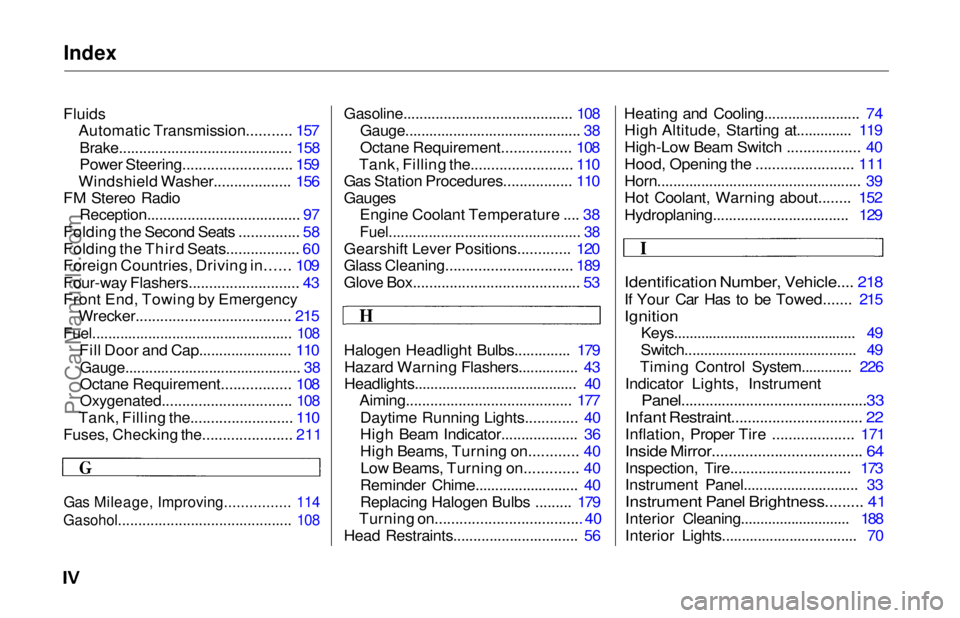
Index
Fluids Automatic Transmission........... 157
Brake........................................... 158
Power Steering........................... 159
Windshield Washer................... 156
FM Stereo Radio
Reception...................................... 97
Folding the Second Seats ............... 58
Folding the Third Seats.................. 60
Foreign Countries, Driving in...... 109
Four-way Flashers........................... 43
Front End, Towing by Emergency Wrecker...................................... 215
Fuel.................................................. 108
Fill Door and Cap....................... 110
Gauge............................................ 38
Octane Requirement................. 108
Oxygenated................................ 108
Tank, Filling the......................... 110
Fuses, Checking the...................... 211
Gas Mileage, Improving................ 114
Gasohol........................................... 108
Gasoline.......................................... 108
Gauge............................................ 38
Octane Requirement................. 108
Tank, Filling the......................... 110
Gas Station Procedures................. 110
Gauges Engine Coolant Temperature .... 38
Fuel................................................ 38
Gearshift Lever Positions............. 120
Glass Cleaning............................... 189
Glove Box......................................... 53
Halogen Headlight Bulbs.............. 179 Hazard Warning Flashers............... 43
Headlights......................................... 40 Aiming......................................... 177
Daytime Running Lights............. 40
High Beam Indicator................... 36
High Beams, Turning on............ 40Low Beams, Turning on............. 40
Reminder Chime.......................... 40
Replacing Halogen Bulbs ......... 179
Turning on....................................
40
Head Restraints...............................
56Heating and Cooling........................ 74
High Altitude, Starting at.............. 119
High-Low Beam Switch .................. 40
Hood, Opening the ........................ 111
Horn................................................... 39
Hot Coolant, Warning about........ 152
Hydroplaning.................................. 129
Identification Number, Vehicle.... 218
If Your Car Has to be Towed....... 215
Ignition
Keys............................................... 49
Switch............................................ 49
Timing Control System............. 226
Indicator Lights, Instrument
Panel..............................................33
Infant Restraint................................ 22
Inflation, Proper Tire .................... 171
Inside Mirror.................................... 64
Inspection, Tire.............................. 173
Instrument Panel............................. 33
Instrument Panel Brightness......... 41
Interior Cleaning............................ 188
Interior Lights.................................. 70ProCarManuals.comMain Menu s t
Page 241 of 241
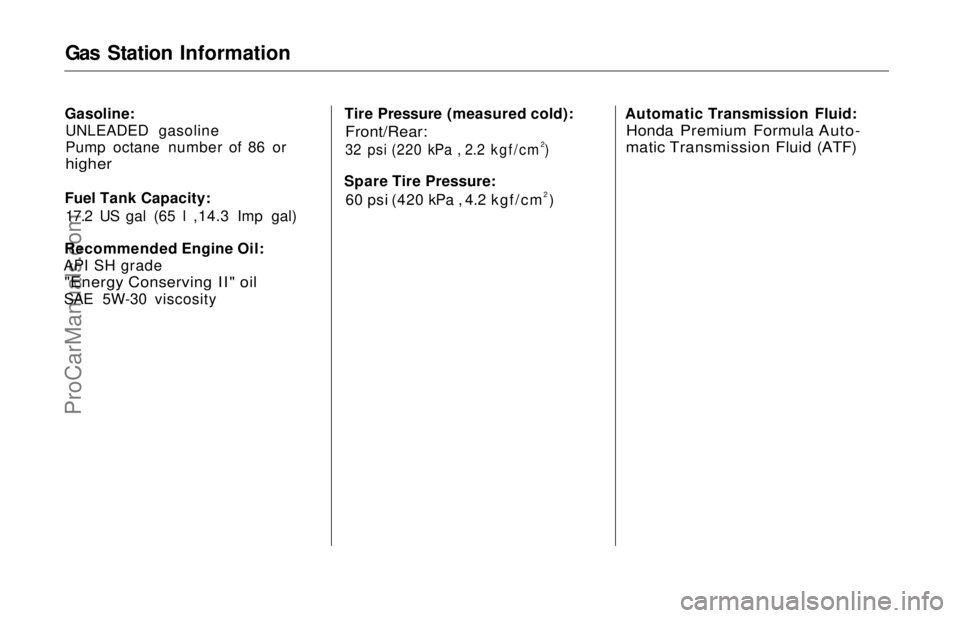
Gas Station Information
Gasoline: UNLEADED gasoline
Pump octane number of 86 or
higher
Fuel Tank Capacity: 17.2 US gal (65 l ,14.3 Imp gal)
Recommended Engine Oil:
API SH grade
"Energy Conserving II" oil
SAE 5W-30 viscosity Tire Pressure (measured cold):
Front/Rear:
32 psi (220 kPa , 2.2 kgf/cm2)
Spare Tire Pressure: 60 psi (420 kPa , 4.2 kgf/cm2) Automatic Transmission Fluid:
Honda Premium Formula Auto-
matic Transmission Fluid (ATF)ProCarManuals.comMain Menu s t